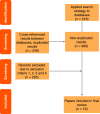The use of 3D-printed models in patient communication: a scoping review
- PMID: 35211330
- PMCID: PMC8852361
- DOI: 10.2217/3dp-2021-0021
The use of 3D-printed models in patient communication: a scoping review
Abstract
3D models have been used as an asset in many clinical applications and a variety of disciplines, and yet the available literature studying the use of 3D models in communication is limited. This scoping review has been conducted to draw conclusions on the current evidence and learn from previous studies, using this knowledge to inform future work. Our search strategy revealed 269 papers, 19 of which were selected for final inclusion and analysis. When assessing the use of 3D models in doctor-patient communication, there is a need for larger studies and studies including a long-term follow up. Furthermore, there are forms of communication that are yet to be researched and provide a niche that may be beneficial to explore.
Keywords: 3D models; 3D printing; communication; rapid prototyping.
© 2022 The authors.
Conflict of interest statement
Financial & competing interests disclosure The authors gratefully acknowledge the support of the British Heart Foundation (CH/17/1/32804), the Bristol BHF Accelerator Award (AA/18/7/34219) and The Grand Appeal (Bristol Children’s Hospital Charity). This study was supported by the NIHR Biomedical Research Centre at University Hospitals Bristol and Weston NHS Foundation Trust and the University of Bristol. J Wray is supported by the NIHR Great Ormond Street Hospital Biomedical Research Centre. The views expressed are those of the authors and not necessarily those of the NIHR or the Department of Health and Social Care. The authors have no other relevant affiliations or financial involvement with any organization or entity with a financial interest in or financial conflict with the subject matter or materials discussed in the manuscript apart from those disclosed. No writing assistance was utilized in the production of this manuscript.
Figures




References
-
- Belasen A, Belasen AT. Doctor–patient communication: a review and a rationale for using an assessment framework. J. Health Organ. Manag. 32(7), 891–907 (2018). - PubMed
-
- Bertakis KD, Azari R. Patient-centered care is associated with decreased health care utilization. J. Am. Board Fam. Med. 24(3), 229–239 (2011). - PubMed
-
- Trummer UF, Mueller UO, Nowak P, Stidl T, Pelikan JM. Does physician–patient communication that aims at empowering patients improve clinical outcome? A case study. Patient Educ. Couns. 61(2), 299–306 (2006). - PubMed
Publication types
Grants and funding
LinkOut - more resources
Full Text Sources
